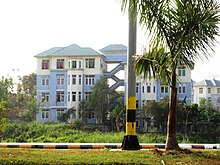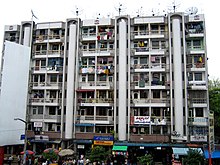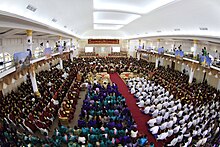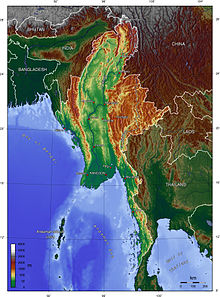Canada ( /ˈkænədə/) is a North American country consisting of ten
provinces and three territories. Located in the northern part of the
continent, it extends from the Atlantic Ocean in the east to the Pacific
Ocean in the west and northward into the Arctic Ocean. It is the
world's second largest country by total area. Canada's common border
with the United States to the south and northwest is the longest in the
world.
The land that is now Canada was inhabited for millennia by
various groups of Aboriginal peoples. Beginning in the late 15th
century, British and French expeditions explored, and later settled,
along the Atlantic coast. France ceded nearly all of its colonies in
North America in 1763 after the Seven Years' War. In 1867, with the
union of three British North American colonies through Confederation,
Canada was formed as a federal dominion of four provinces. This began an
accretion of provinces and territories and a process of increasing
autonomy from the United Kingdom. This widening autonomy was highlighted
by the Statute of Westminster 1931 and culminated in the Canada Act
1982, which severed the vestiges of legal dependence on the British
parliament.
Canada is a federal state that is governed as a
parliamentary democracy and a constitutional monarchy with Queen
Elizabeth II as its head of state. It is a bilingual nation with both
English and French as official languages at the federal level. One of
the world's highly developed countries, Canada has a diversified economy
that is reliant upon its abundant natural resources and upon
trade—particularly with the United States, with which Canada has had a
long and complex relationship. It is a member of the G7, G8, G20, NATO,
OECD, WTO, Commonwealth of Nations, Francophonie, OAS, APEC, and UN.
With the eighth-highest Human Development Index globally, it has one of
the highest standards of living in the world.
Geography
Canada occupies a major northern portion
of North America, sharing the land borders with the contiguous United
States to the south and the U.S. state of Alaska to the northwest,
stretching from the Atlantic Ocean in the east to the Pacific Ocean in
the west; to the north lies the Arctic Ocean.By total area (including
its waters), Canada is the second-largest country in the world, after
Russia. By land area, Canada ranks fourth.
The country lies
between latitudes 41° and 84°N, and longitudes 52° and 141°W. Since
1925, Canada has claimed the portion of the Arctic between 60° and 141°W
longitude, but this claim is not universally recognized. The
northernmost settlement in Canada (and in the world) is Canadian Forces
Station Alert on the northern tip of Ellesmere Island—latitude
82.5°N—817 kilometres (450 nautical miles, 508 miles) from the North
Pole Much of the Canadian Arctic is covered by ice and permafrost.
Canada also has the longest coastline in the world: 202,080 kilometres
(125,570 mi).
Since the last glacial period Canada has consisted
of eight distinct forest regions, including extensive boreal forest on
the Canadian Shield. Canada has more lakes than any other country,
containing much of the world's fresh water.There are also fresh-water
glaciers in the Canadian Rockies and the Coast Mountains. Canada is
geologically active, having many earthquakes and potentially active
volcanoes, notably Mount Meager, Mount Garibaldi, Mount Cayley, and the
Mount Edziza volcanic complex. The volcanic eruption of Tseax Cone in
1775 caused a catastrophic disaster, killing 2,000 Nisga'a people and
destroying their village in the Nass River valley of northern British
Columbia; the eruption produced a 22.5-kilometre (14.0 mi) lava flow,
and according to legend of the Nisga'a people, it blocked the flow of
the Nass River.
The population density, 3.3 inhabitants
per square kilometre (8.5 /sq mi), is among the lowest in the world.
The most densely populated part of the country is the Quebec City –
Windsor Corridor, situated in Southern Quebec and Southern Ontario along
the Great Lakes and the Saint Lawrence River.
Average winter and
summer high temperatures across Canada vary according to the location.
Winters can be harsh in many regions of the country, particularly in the
interior and Prairie provinces, which experience a continental climate,
where daily average temperatures are near −15 °C (5 °F) but can drop
below −40 °C (−40 °F) with severe wind chills.In noncoastal regions,
snow can cover the ground almost six months of the year (more in the
north). Coastal British Columbia has a temperate climate, with a mild
and rainy winter. On the east and west coasts, average high temperatures
are generally in the low 20s °C (70s °F), while between the coasts, the
average summer high temperature ranges from 25 to 30 °C (77 to 86 °F),
with occasional extreme heat in some interior locations exceeding 40 °C
(104 °F).
Demographics
The
Canada 2006 Census counted a total population of 31,612,897, an
increase of 5.4 percent since 2001. Population growth is from
immigration and, to a lesser extent, natural growth. About four-fifths
of Canada's population lives within 150 kilometres (93 mi) of the United
States border.A similar proportion live in urban areas concentrated in
the Quebec City – Windsor Corridor, the BC Lower Mainland, and the
Calgary–Edmonton Corridor in Alberta.In common with many other developed
countries, Canada is experiencing a demographic shift towards an older
population, with more retirees and fewer people of working age. In 2006,
the average age of the population was 39.5 years.
According to
the 2006 census, the largest self-reported ethnic origin is Canadian
(32%), followed by English (21%), French (15.8%), Scottish (15.1%),
Irish (13.9%), German (10.2%), Italian (4.6%), Chinese (4.3%), First
Nations (4.0%), Ukrainian (3.9%), and Dutch (3.3%). There are 600
recognized First Nations governments or bands encompassing 1,172,790
people.
Canada's Aboriginal population is growing at almost twice
the national rate, and 3.8 percent of Canada's population claimed
aboriginal identity in 2006. Another 16.2 percent of the population
belonged to a non-aboriginal visible minority.The largest visible
minority groups in Canada are South Asian (4.0%), Chinese (3.9%) and
Black (2.5%). Between 2001 and 2006, the visible minority population
rose by 27.2 percent In 1961, less than two percent of Canada's
population (about 300,000 people) could be classified as belonging to a
visible minority group and less than 1% as aboriginal.As of 2007, almost
one in five Canadians (19.8%) were foreign-born. Nearly 60 percent of
new immigrants come from Asia (including the Middle East).The leading
emigrating countries to Canada were China, Philippines and India.By
2031, one in three Canadians could belong to a visible minority group.
Canada
has one of the highest per-capita immigration rates in the world,driven
by economic policy and family reunification, and is aiming for between
240,000 and 265,000 new permanent residents in 2011, the same number of
immigrants as in recent years.New immigrants settle mostly in major
urban areas like Toronto and Vancouver.Canada also accepts large numbers
of refugees.The country resettles over one in 10 of the world’s
refugees.
According to the 2001 census, 77.1 percent of Canadians
identify as being Christians; of this, Catholics make up the largest
group (43.6% of Canadians). The largest Protestant denomination is the
United Church of Canada (9.5% of Canadians), followed by the Anglicans
(6.8%), Baptists (2.4%), Lutherans (2%), and other Christians (4.4%).
About 16.5 percent of Canadians declare no religious affiliation, and
the remaining 6.3 percent are affiliated with non-Christian religions,
the largest of which is Islam (2.0%), followed by Judaism (1.1%).
Canadian
provinces and territories are responsible for education. Each system is
similar, while reflecting regional history, culture and geography. The
mandatory school age ranges between 5–7 to 16–18 years, contributing to
an adult literacy rate of 99 percent. In 2002, 43 percent of Canadians
aged 25 to 64 possessed a post-secondary education; for those aged 25 to
34, the rate of post-secondary education reached 51 percent.
Language
Canada's two official languages are English
and French. Official bilingualism is defined in the Canadian Charter of
Rights and Freedoms, the Official Languages Act, and Official Language
Regulations; it is applied by the Commissioner of Official Languages.
English and French have equal status in federal courts, Parliament, and
in all federal institutions. Citizens have the right, where there is
sufficient demand, to receive federal government services in either
English or French, and official-language minorities are guaranteed their
own schools in all provinces and territories.
English and French
are the first languages of 59.7 and 23.2 percent of the population
respectively. Approximately 98 percent of Canadians speak English or
French: 57.8% speak English only, 22.1% speak French only, and 17.4%
speak both. English and French Official Language Communities, defined by
First Official Language Spoken, constitute 73.0 and 23.6 percent of the
population respectively.
The Charter of the French Language makes
French the official language in Quebec.Although more than 85 percent of
French-speaking Canadians live in Quebec, there are substantial
Francophone populations in Ontario, Alberta, and southern Manitoba;
Ontario has the largest French-speaking population outside Quebec. New
Brunswick, the only officially bilingual province, has a French-speaking
Acadian minority constituting 33 percent of the population. There are
also clusters of Acadians in southwestern Nova Scotia, on Cape Breton
Island, and through central and western Prince Edward Island.
Other
provinces have no official languages as such, but French is used as a
language of instruction, in courts, and for other government services in
addition to English. Manitoba, Ontario, and Quebec allow for both
English and French to be spoken in the provincial legislatures, and laws
are enacted in both languages. In Ontario, French has some legal status
but is not fully co-official. There are 11 Aboriginal language groups,
made up of more than 65 distinct dialects. Of these, only Cree,
Inuktitut and Ojibway have a large enough population of fluent speakers
to be considered viable to survive in the long term. Several aboriginal
languages have official status in the Northwest Territories.Inuktitut is
the majority language in Nunavut, and one of three official languages
in the territory.
Over six million people in Canada list a
non-official language as their mother tongue. Some of the most common
non-official first languages include Chinese (mainly Cantonese;
1,012,065 first-language speakers), Italian (455,040), German (450,570),
Punjabi (367,505) and Spanish (345,345). and the languages most spoken
at home by 68.3 percent and 22.3 percent of the population respectively.
Miss Canada 2012:
![Location of Czech Republic (dark green)– in Europe (green & dark grey)– in the European Union (green) — [Legend]](http://upload.wikimedia.org/wikipedia/commons/thumb/3/33/EU-Czechia.svg/250px-EU-Czechia.svg.png)
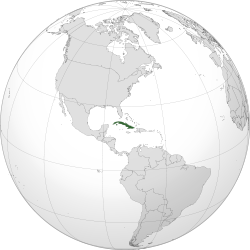
![Location of Croatia (green)– in Europe (peach orange & dark grey)– in the European Union (peach orange) — [Legend]](http://upload.wikimedia.org/wikipedia/commons/thumb/1/15/EU-Croatia.svg/250px-EU-Croatia.svg.png)

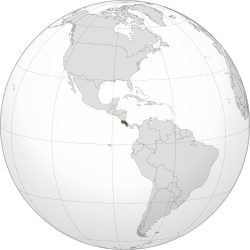


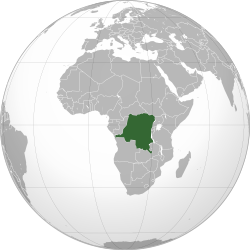


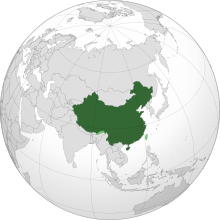




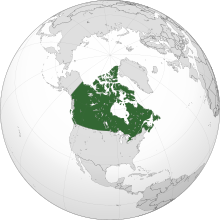



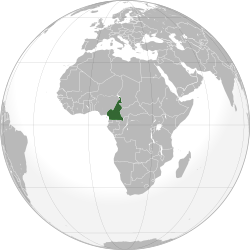
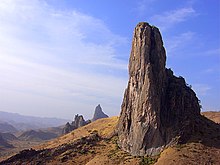


![Location of Cambodia (green)in ASEAN (dark grey) — [Legend]](http://upload.wikimedia.org/wikipedia/commons/thumb/9/91/Location_Cambodia_ASEAN.svg/250px-Location_Cambodia_ASEAN.svg.png)

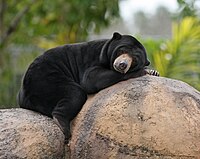




![Location of Burma (green)in ASEAN (dark grey) — [Legend]](http://upload.wikimedia.org/wikipedia/commons/thumb/b/b8/Location_Burma_%28Myanmar%29_ASEAN.svg/250px-Location_Burma_%28Myanmar%29_ASEAN.svg.png)
